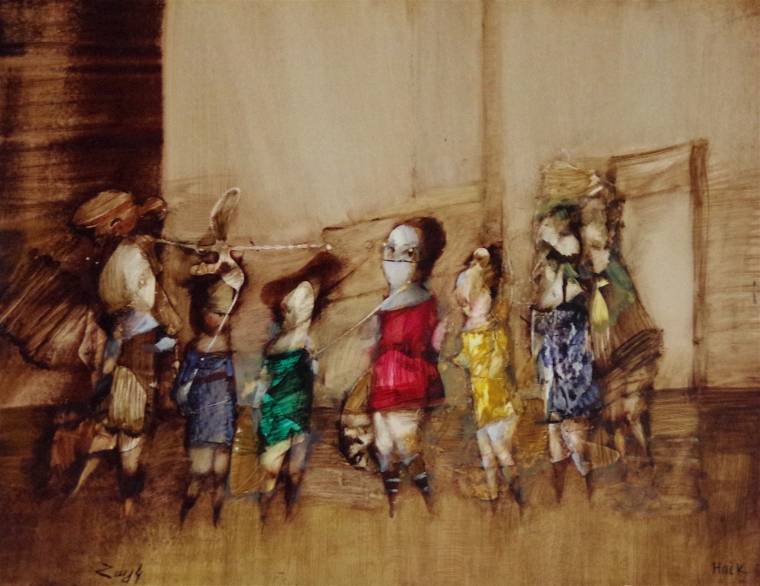Discovering the Depths of Emotion with Figurative Oil Painting Methods
Discovering the Depths of Emotion with Figurative Oil Painting Methods
Blog Article
The Function of Feeling and Expression in Metaphorical Oil Paint: An Extensive Evaluation of Subject Issue and Structure
The interplay of emotion and expression in metaphorical oil paint functions as a vital lens through which one can examine the elaborate connection in between subject and structure. Artists harness numerous strategies, from color selection to brushstroke dynamics, to cultivate emotional resonance within their jobs. This nuanced orchestration not just forms audience assumption but additionally invites a deeper questions right into exactly how these elements coalesce to reflect the intricacies of human experience. As we explore this abundant surface, one have to consider how certain study light up the wider implications of these creative options.
Comprehending Emotion in Art
Emotion in art functions as a powerful conduit for expression, enabling artists to share complex feelings with their work. In figurative oil paint, this psychological depth is typically portrayed through the representation of the human figure, capturing the nuances of human experience. The option of subject matter, color scheme, and brushwork all add to the psychological vibration of an item.
Artists frequently attract upon personal experiences, social problems, or global themes to evoke feelings in the customer. A portrait might reflect vulnerability, while a vibrant number in activity can signify freedom or turmoil. These psychological strings connect the audience to the art work, fostering a dialogue that goes beyond the visual medium.
In addition, the interaction between light and shadow can amplify psychological strength, assisting the visitor's stare and accentuating particular components within the make-up. The use of appearance in oil painting further includes layers of complexity, inviting a responsive action that enhances the emotional experience. In general, comprehending feeling in art is crucial for appreciating the nuances that identify metaphorical oil painting, as it transforms plain depiction into a profound exploration of the human problem.
Crucial Element of Composition
In the world of figurative oil paint, the composition functions as the underlying structure that organizes aesthetic elements and boosts the emotional story. Important parts of structure include equilibrium, comparison, prime focus, and rhythm, each adding to the total effect of the artwork.
Equilibrium describes the circulation of aesthetic weight within the paint, which can be attained with symmetrical or unbalanced arrangements. A healthy composition gives stability, permitting the audience to involve with the item sympathetically - figurative oil painting. Contrast, on the various other hand, entails juxtaposing various aspects, such as dark and light or warm and amazing colors, to assist the customer's eye and stimulate emotional feedbacks
The focal factor is crucial, as it routes attention to the most substantial part of the painting, usually highlighting the psychological core of the story. By masterfully integrating these essential components, musicians can craft engaging and emotionally powerful figurative oil paintings that captivate and involve their audience.
Topic and Its Influence
Subject plays an essential role in metaphorical oil painting, as it not only functions as the structure for the story but also shapes the customer's interpretation and psychological involvement with the art work. The option of subject-- be it a solitary number, a group dynamic, or a thematic depiction-- directly influences the psychological environment shared to the audience.

For circumstances, pictures typically stimulate individual connections, exposing the ins and outs of human expression and personality, while scenes illustrating communal activities can produce a sense of belonging or nostalgia. The historical and social context of the subject matter improves the audience's understanding, motivating much deeper reflections on social norms, values, and the human problem.
Different subjects also create differing levels of involvement; a dramatic conflict illustrated through figures in stress may generate sensations of anxiety or compassion, while serene landscapes can invoke harmony and contemplation. Eventually, the influence of subject issue in metaphorical oil paint check these guys out is profound, as Your Domain Name it functions as an avenue for emotional vibration, assisting the audience's feedback and interpretation, and fostering a link between the viewer and the art work. This interplay is crucial for the successful communication of the artist's intent.
Methods for Stimulating Sensations
The performance of metaphorical oil paint in conveying feelings is significantly influenced by the techniques employed by the artist. One of the most important techniques is the usage of shade concept, where the strategic selection of hues can evoke certain psychological actions. Cozy colors, such as oranges and reds, often elicit feelings of interest or aggressiveness, while cooler tones like blues and eco-friendlies have a tendency to stimulate peace or despair.
Another important technique is the manipulation of light and darkness, understood as chiaroscuro. This method enhances the three-dimensionality of numbers, producing remarkable contrasts that can intensify emotional depth. The positioning of light can assist audiences' feelings, highlighting details components of the structure.
Brushwork also plays an essential duty; loose, meaningful strokes can communicate energy and spontaneity, whereas smoother strategies may recommend peace or precision. The plan of topics within the make-up can influence psychological impact. Close proximity can suggest affection, while range might show seclusion.
Eventually, the mix of these techniques makes it possible for musicians to craft narratives that reverberate with the customer, changing a simple aesthetic experience into an expressive emotional journey. - figurative oil painting

Instance Studies of Remarkable Functions
Examining significant important site jobs of figurative oil painting discloses how different strategies are employed to evoke effective emotions. One exemplary situation is Edvard Munch's "The Scream," where the altered number and swirling background share existential fear. Munch's use shade-- deep blues and dazzling oranges-- increases the psychological impact, showcasing how combination choices can shape customer experience.
Another substantial work is Pablo Picasso's "Les Demoiselles d'Avignon." Here, fragmented forms and bold brushstrokes mirror a turbulent psychological landscape, testing typical depictions of the women number. Picasso's cutting-edge make-up not just catches the audience's interest but also invites reflection on motifs of identification and sexuality.
Furthermore, Frida Kahlo's "The 2 Fridas" provides a poignant exploration of duality and self-identity. The different numbers, linked by a shared heart, exhibit Kahlo's psychological depth and personal story. figurative oil painting. Her thorough interest to detail and symbolic elements offer to involve customers on a visceral level
These case researches emphasize the profound connection in between emotion and composition in figurative oil paint, exposing how artists harness technique to interact complex sensations and stories that reverberate throughout time and society.

Conclusion
To conclude, the interplay of feeling and expression in figurative oil painting considerably boosts the audience's experience and analysis of the art work. Through a cautious option of topic and compositional methods, musicians convey extensive stories that resonate on both global and personal degrees. The application of shade theory, chiaroscuro, and brushwork additional amplifies emotional deepness, changing each canvas into an effective representation of the complexities of the human experience.
In figurative oil painting, this psychological deepness is typically represented through the depiction of the human number, recording the subtleties of human experience.Furthermore, the interplay in between light and darkness can amplify emotional strength, leading the viewer's look and attracting focus to particular aspects within the structure. The usage of texture in oil painting even more adds layers of complexity, inviting a responsive action that boosts the psychological experience.The focal factor is essential, as it guides interest to the most considerable component of the paint, usually highlighting the psychological core of the story. Ultimately, the impact of subject matter in figurative oil painting is profound, as it offers as an avenue for psychological vibration, guiding the audience's action and analysis, and cultivating a link in between the viewer and the artwork.
Report this page